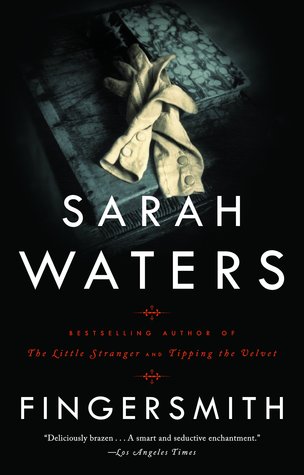The Fingersmith by Sarah Waters

First published: 2002
Found: After watching the 2005 BBC adaptation in the year of its release, directed by Ailing Walsh and starring Sally Hawkins and Imelda Staunton, I found this is my local regional library
Pages/read time: 592, a week
Comments:
Someone at a podium in front of a room full of people, me being one of those people, once said that certain books and certain ideas can (and should) become like ‘part of the furniture of your mind’. A stable piece of something that you know so well, rely on so much, and lean into time and again. Though many may argue the literary merit of Sarah Waters’ writing, her works have become part of the Ikea-of-ideas catalogue that I regularly peruse, and The Fingersmith is one of my comfiest chairs.
As you can tell by my penchant for pre-1910 English language literature, I am rather fond of period prose. From a young age I had high standards. Austen, Brontë(s), Elliott – I crushed on them all and could recite their respective BBC and Hollywood adaptations by heart. As with most things classically orientated though, there was not an excellent representation of modern attitudes to be found in my desired period aesthetic. Read: there were no gays. Compound this with growing up in an Australian regional town, and the term ‘queer’ literature was pretty much limited to anything written by Dr. Seuss. Sarah Waters’s novels filled the (then) void of my queer, pre-1950s yearnings.* Waters has a knack of writing modern prose in a classical cadence, with narratives that are at once more down to earth and accessible than Austen, yet does not sensationalise her subject. The draw card isn’t the sex (which is, honestly, minimal), it’s the common decency and respect of proper development queer characters still don’t often receive. The Fingersmith is by far my favourite, probably more for sentimental than for prose reasons – I know it so, so well.
I felt that thread that had come between us, tugging, tugging at my heart – so hard, it hurt me. A hundred times I almost rose, almost went in to her; a hundred times I thought, Go to her! Why are you waiting? Go back to her side! But every time, I thought of what would happen if I did. I knew that I couldn’t lie beside her, without wanting to touch her. I couldn’t have felt her breath upon my mouth, without wanting to kiss her. And I couldn’t have kissed her, without wanting to save her.
Part one of the novel is narrated by Sue, a young woman raised and living among the London ‘underclass’ of thieves at an unspecified time in the 19th century. Her landlady/adopted mother hatches a plot with a well known con-man ‘Gentleman’ to have Sue pose as a ladies maid to an unmarried, gullible heiress in the country. Gentleman trains Sue and coaches her to convince the lady, Maud, that she is in love with him (he poses as a suitable, eligible match). Things go awry for Sue when she meets and starts to care for Maud, and finds herself inextricably attracted to her; then suddenly, Sue finds herself in Maud’s place in a madhouse.
She was like milk – too pale, too pure, too simple. She was made to be spoiled.
Part two begins the story again, this time from Maud’s perspective. The cloistered, sheltered life we are lead to imagine she leads in the first half of the novel turns out to something just short of perverse servitude. Maud, the ward of an older male relative, is forced to read to potential buyers extracts of detailed and wide-ranging pornographic literature from his collection. The Gentleman offers her an escape, twisting the complexity of Waters’ plot which only deepens in suspense as Maud seemingly reciprocates Sue’s affections. That is, until Maud discovers her true identity.
“My happiness is nothing to him,” she said. “Only his books! He has made me like a book. I am not meant to be taken, and touched, and liked. I am meant to keep here, in dim light, forever!”
There is really so much more to this plot than the lesbian, but telling you anymore would spoil to intricacies and my teenage-self was rather obsessed with sexuality at the time (it’s excusable). Suffice to say, Waters doesn’t queer-bait and I am so glad her works were some of my earliest memories of solid LGBTQIA+ contemporary culture. Waters, just like Austen and my bevvy of Victoria lady-bosses before her, set the bar high, and maintained the standard. I read everything by Waters. Affinity, The Little Stranger, The Night Watch and her most sexualised novel, Tipping the Velvet are comparable in complexity and sensuality, as well as their feminist and class-critical undertones. What I had not realised, caught up in my own analog appreciation fandom of Waters and her writing, was her influence beyond the progressive English-speaking world.
I was bemused once to find myself in a cinema, mistakenly thinking I had paid to see an adaptation of The Handmaid’s Tale, when actually I was watching the 2016 Korean/Japanese take on Waters’ narrative (entitled The Handmaiden) with even more,turns than the original (and a squid). Though this adaptation was less heart-wrenching than the original, I was delighted. Ten years into my autonomous adulthood, queer content is finally getting queer remakes. I can finally see pieces of my metaphorical furniture in the everyday contemporary shared spaces.
I highly recommend this to any die-hard classics fan who would like the grit of Dickens without the ponderous descriptions of waistcoats and men’s pipes, the class-consciousness of Gaskell without the fixation on men, and the forthrightness of Elliott – with lesbians.
*and the 1999 film, Aimée and Jaguar
